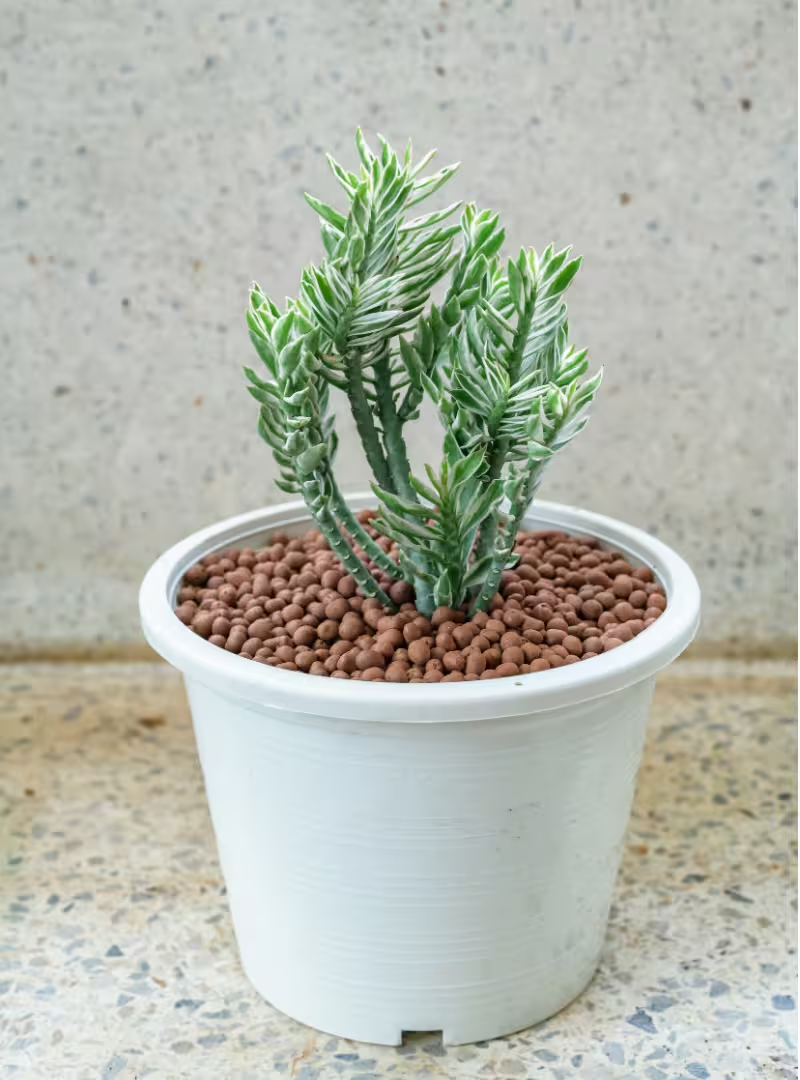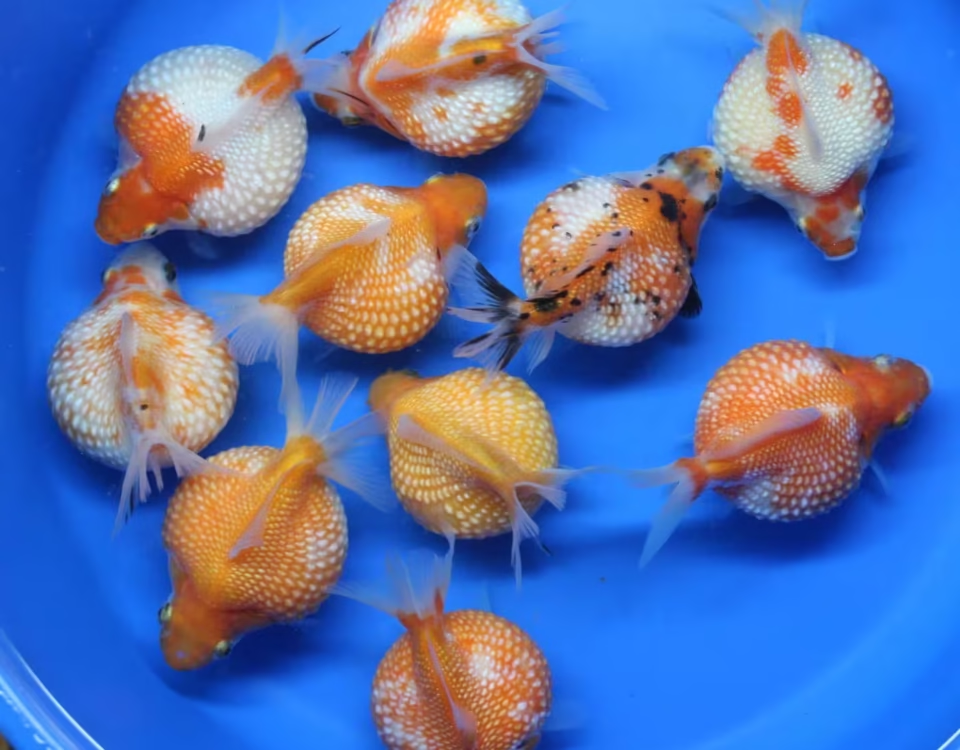The Ultimate Snail Care Encyclopedia
Discover everything about snail care covering all major species worldwide. This definitive guide provides comprehensive information on snail types, complete care instructions, health concerns, breeding details, and buying advice to help you become an expert snail keeper.
40,000+ Species
Snail varieties worldwide across habitats
0.6mm - 90cm
Size range from tiny to giant species
1-15 years
Average lifespan with proper care
3 Main Habitats
Land, freshwater, and marine environments
Snail Species & Varieties
With over 40,000 snail species globally, they come in an incredible variety of sizes, shapes, and characteristics. Below are the major categories and some popular species:
Land Snail Species (~25,000 species)
Terrestrial snails inhabit diverse environments from rainforests to deserts. Below are some of the most notable land snail species:
| Category | Size Range | Characteristics | Habitat | Notable Species |
|---|---|---|---|---|
| Giant Land Snails | 10-20 cm | Large size, herbivorous, popular as pets | Tropical forests | Giant African Land Snail, Roman Snail |
| Garden Snails | 2-5 cm | Common worldwide, agricultural pests | Gardens, farms | Garden Snail, White-Lipped Snail |
| Tree Snails | 3-7 cm | Arboreal, colorful shells | Rainforest canopies | Candy Cane Snail, Partula Snails |
| Desert Snails | 1-4 cm | Adapted to arid conditions | Deserts | Sphincterochila boissieri |
| Cave Snails | 0.5-3 cm | Pale, often blind, specialized | Cave systems | Croatian Cave Snail |
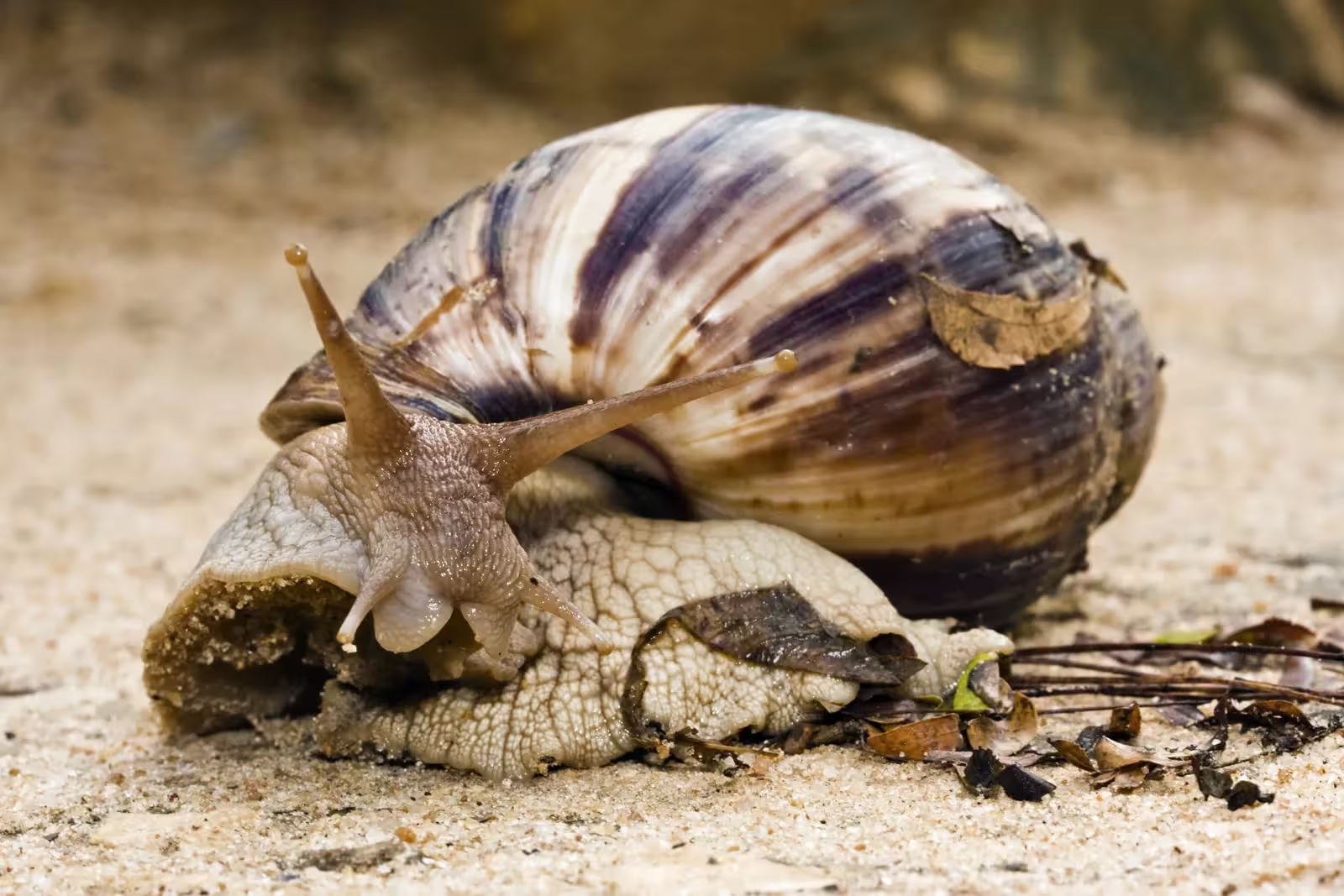
Giant African Land Snail
Achatina fulicaOne of the largest land snails, growing up to 20 cm. Highly invasive species but popular in captivity. Herbivorous diet with calcium requirements for shell growth.
Key Traits: Fast growth, prolific breeder, requires high humidity (70-90%)
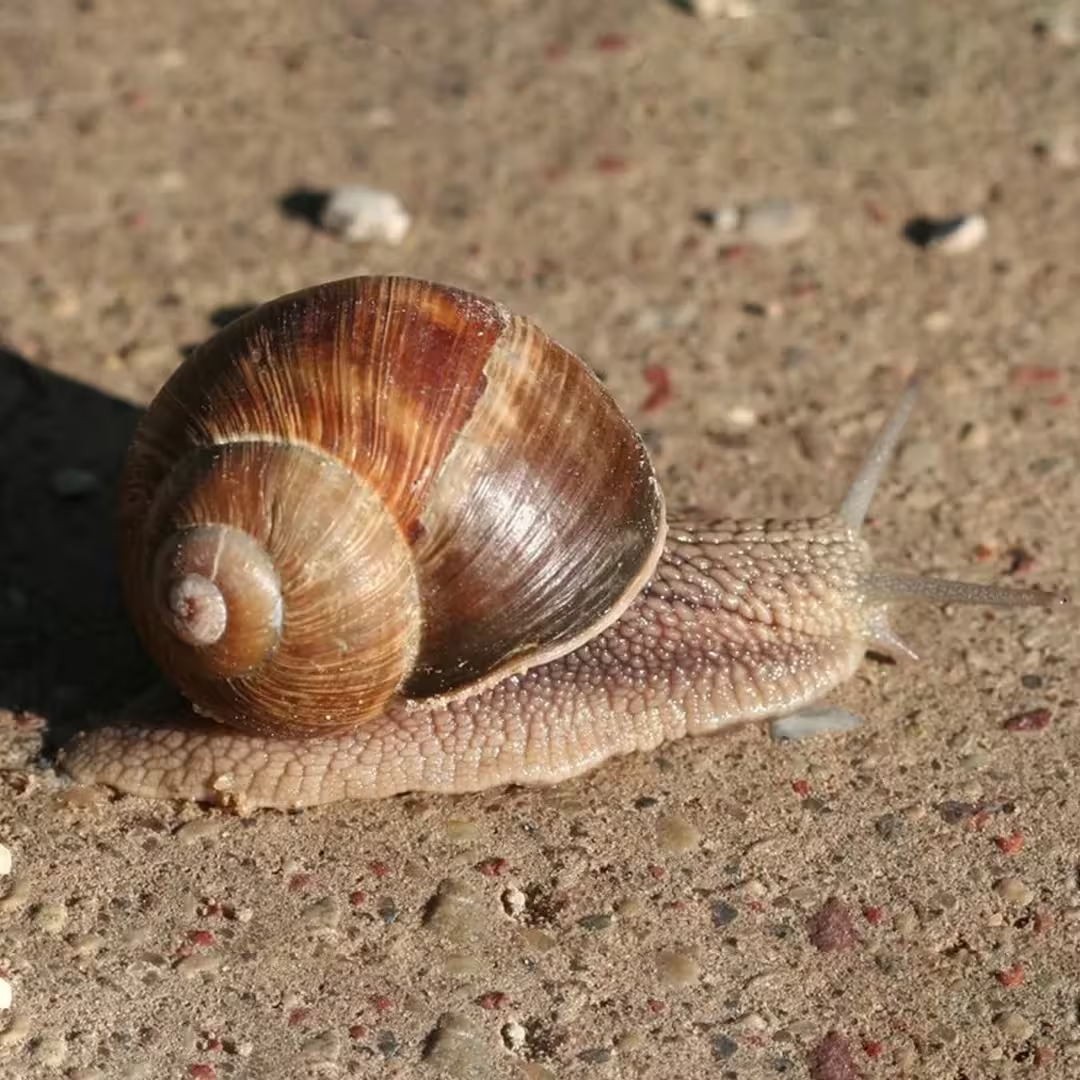
Roman Snail
Helix pomatiaThe classic edible escargot snail. Creamy shell with brown bands. Hibernates in winter by sealing its shell. Protected in many European countries.
Key Traits: Edible, slow-growing, lifespan 5-10 years
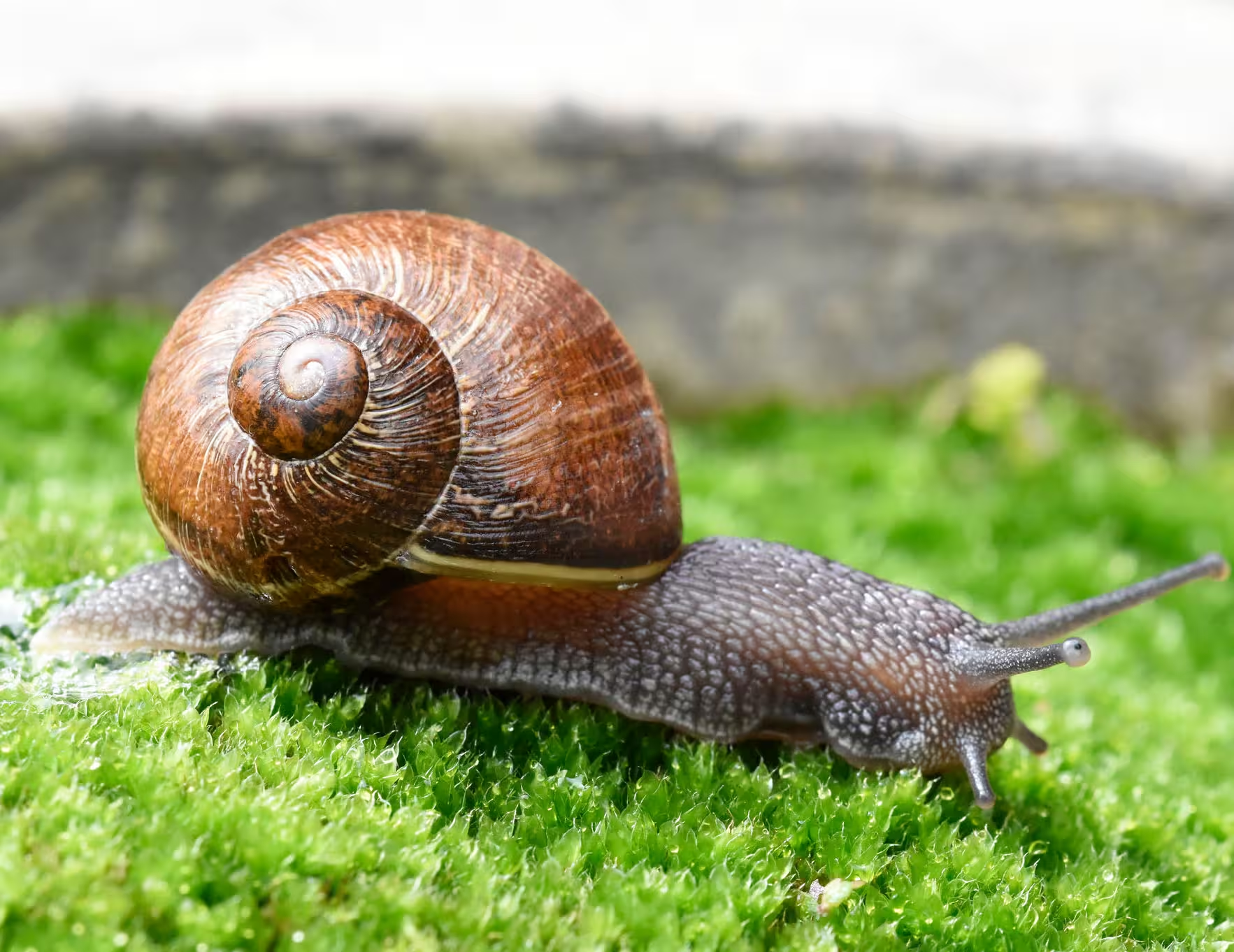
Garden Snail
Cornu aspersumThe most widespread land snail globally. Recognizable by its brown, ribbed shell. Considered both a garden pest and important decomposer.
Key Traits: Highly adaptable, edible, lifespan 2-5 years
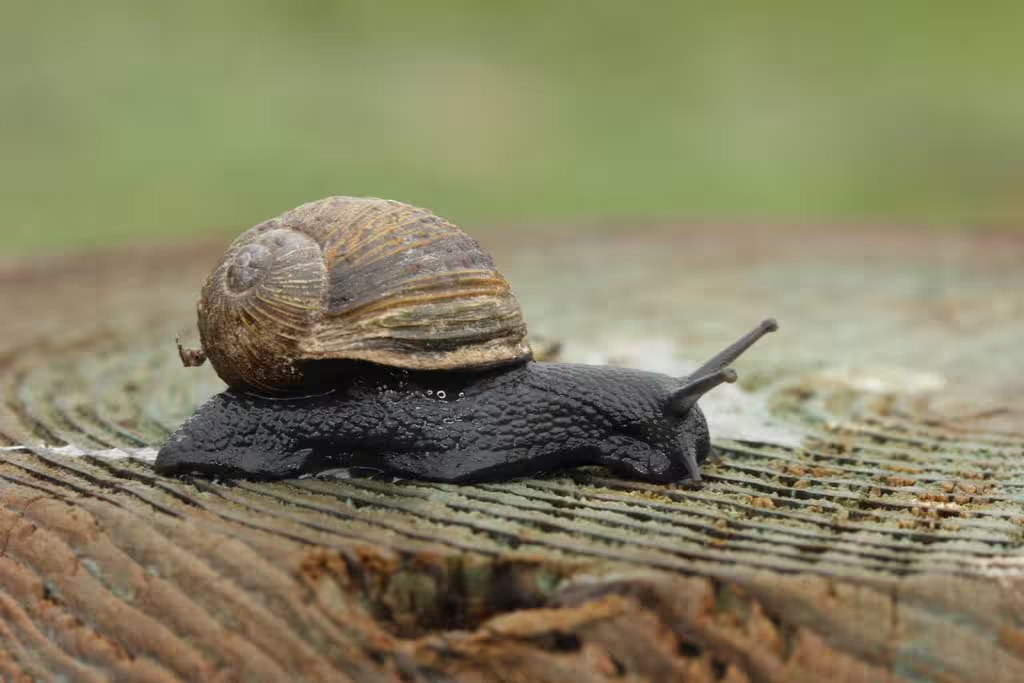
Mediterranean Green Snail
Cantareus apertusDistinctive greenish-yellow shell with dark bands. Active after rains in Mediterranean climates. Popular in terrariums for its attractive appearance.
Key Traits: Drought-resistant, aestivates in summer, lifespan 3-5 years

White-Lipped Snail
Cepaea hortensisClose relative of the grove snail with a distinctive white lip at shell opening. Shell color polymorphism makes it a model for evolutionary studies.
Key Traits: Color variations, prefers moist habitats, lifespan 2-3 years
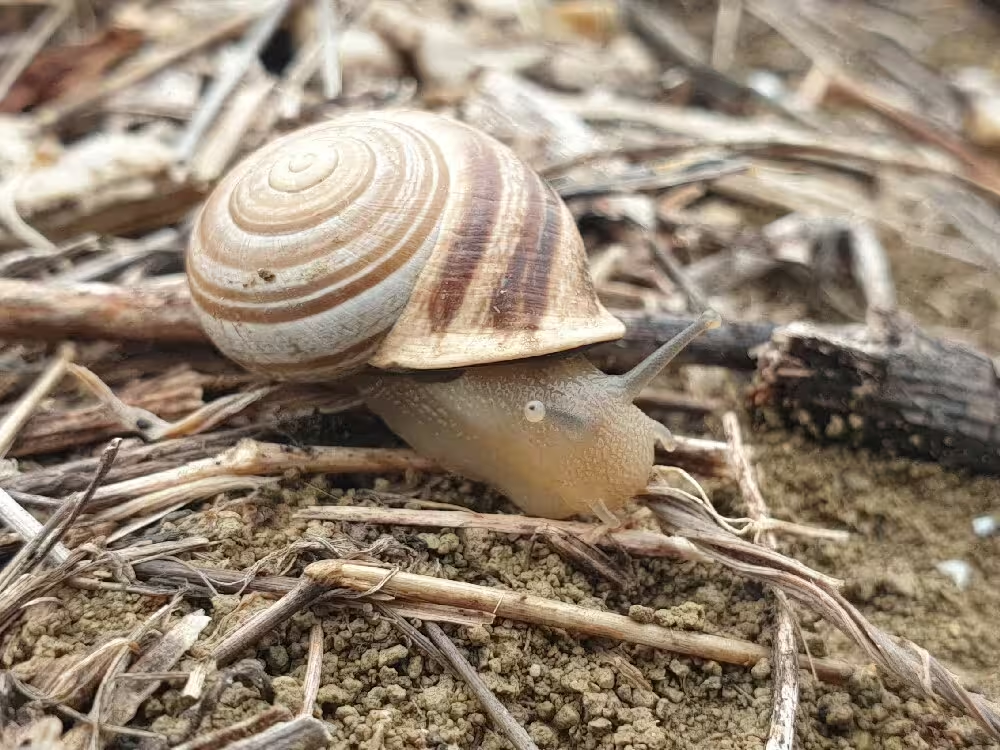
Milk Snail
Otala lacteaNamed for its milky white shell. Another edible species used in escargot dishes. Can survive long periods without food or water by aestivating.
Key Traits: Edible, drought-resistant, lifespan 5-7 years

Candy Cane Snail
Liguus virgineusOne of the most colorful land snails with rainbow-striped shell. Tree-dwelling species found in Caribbean islands. Highly sought by collectors.
Key Traits: Vibrant colors, arboreal, lifespan 5-7 years
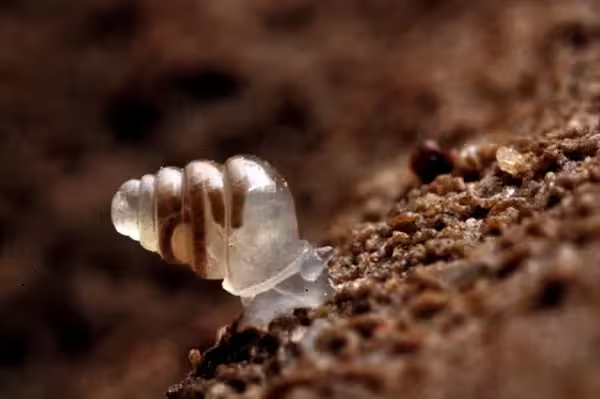
Croatian Cave Snail
Zospeum tholussumExtremely specialized cave-dwelling snail with transparent shell. Found only in deep cave systems in Croatia. Blind and moves very slowly.
Key Traits: Cave-adapted, transparent shell, extremely rare
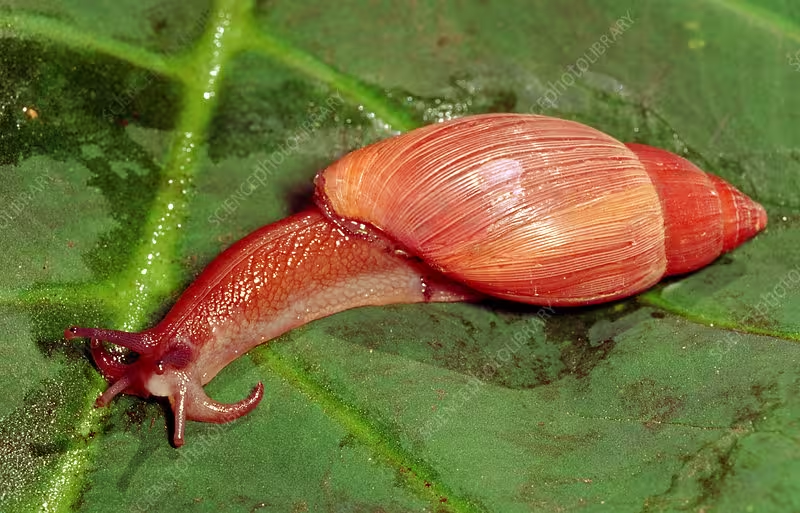
Rosy Wolf Snail
Euglandina roseaCarnivorous snail that preys on other snails. Introduced in some areas for pest control but became invasive itself. Recognizable by its pinkish shell.
Key Traits: Predatory, fast-moving for a snail, lifespan 3-5 years
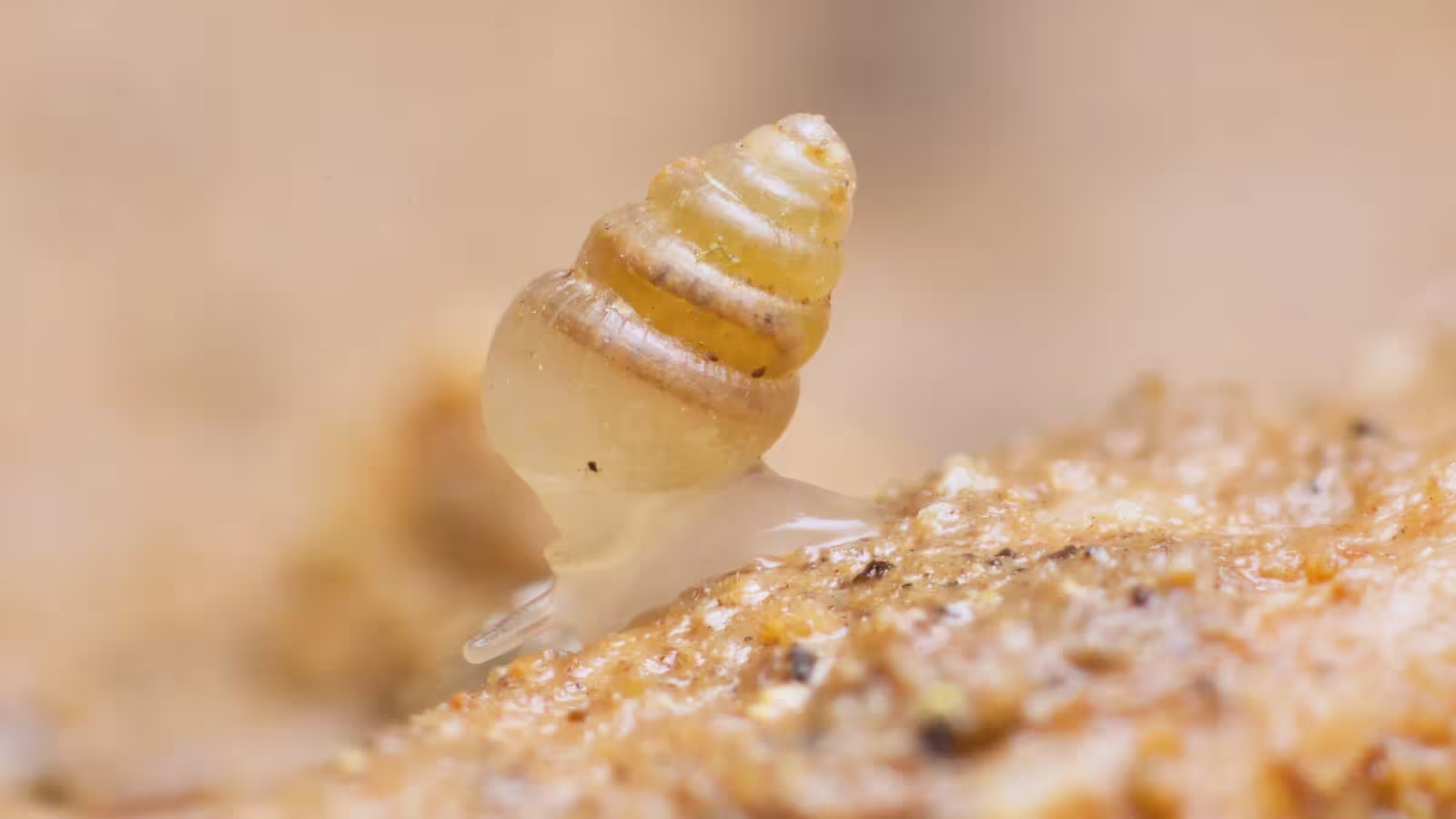
World's Smallest Snail
Angustopila psammionThe smallest known land snail at just 0.6mm in diameter. Found in Vietnam's limestone caves. Entire shell could fit through the eye of a needle.
Key Traits: 0.6mm size, limestone specialist, extremely rare

Desert Snail
Sphincterochila boissieriRemarkably adapted to desert life. Can survive years without water by sealing its shell and entering dormancy. Found in Middle Eastern deserts.
Key Traits: Extreme drought tolerance, white shell reflects heat
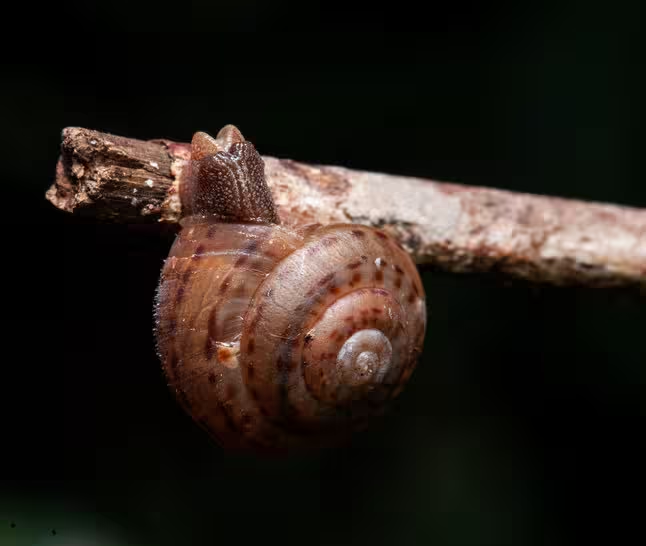
Amazonian Tree Snail
Solaropsis penthesileaeBeautiful Amazonian snail with striking shell patterns. Named after Greek mythology's Penthesilea. Lives in rainforest canopies feeding on algae and fungi.
Key Traits: Colorful patterns, arboreal, humidity-dependent
Conservation Note
Many land snail species are threatened by habitat loss and climate change. Some island species like the Partula snails have been driven to extinction by invasive predators. Always research conservation status before collecting wild snails.
Freshwater Snail Species (~5,000 species)
Freshwater snails inhabit lakes, rivers, ponds, and streams worldwide. Many are popular in aquariums for their algae-eating abilities.
| Category | Size Range | Characteristics | Habitat | Notable Species |
|---|---|---|---|---|
| Apple Snails | 5-15 cm | Large, round shells, herbivorous | Ponds, slow rivers | Golden Apple Snail, Mystery Snail |
| Nerite Snails | 1-3 cm | Excellent algae eaters, colorful patterns | Brackish/freshwater | Zebra Nerite, Tiger Nerite |
| Ramshorn Snails | 1-4 cm | Flat coiled shells, rapid breeders | Ponds, aquariums | Red Ramshorn, Giant Ramshorn |
| Trumpet Snails | 1-3 cm | Burrow in substrate, nocturnal | Aquariums, lakes | Malaysian Trumpet Snail |
| Assassin Snails | 2-3 cm | Carnivorous, eat other snails | Aquariums | Clea helena |

Apple Snail
Pomacea spp.Large, globular snails popular in aquariums. Come in various colors including gold, blue, and ivory. Excellent algae eaters but may eat aquarium plants.
Key Traits: Amphibious (has both gills and lung), lays pink egg clusters above water

Mystery Snail
Pomacea bridgesiiPopular aquarium snail with colorful varieties (blue, gold, ivory). Peaceful and won't eat healthy plants. Gets its name from its mysterious appearance in aquariums.
Key Traits: Safe for planted tanks, lifespan 1-2 years, needs calcium
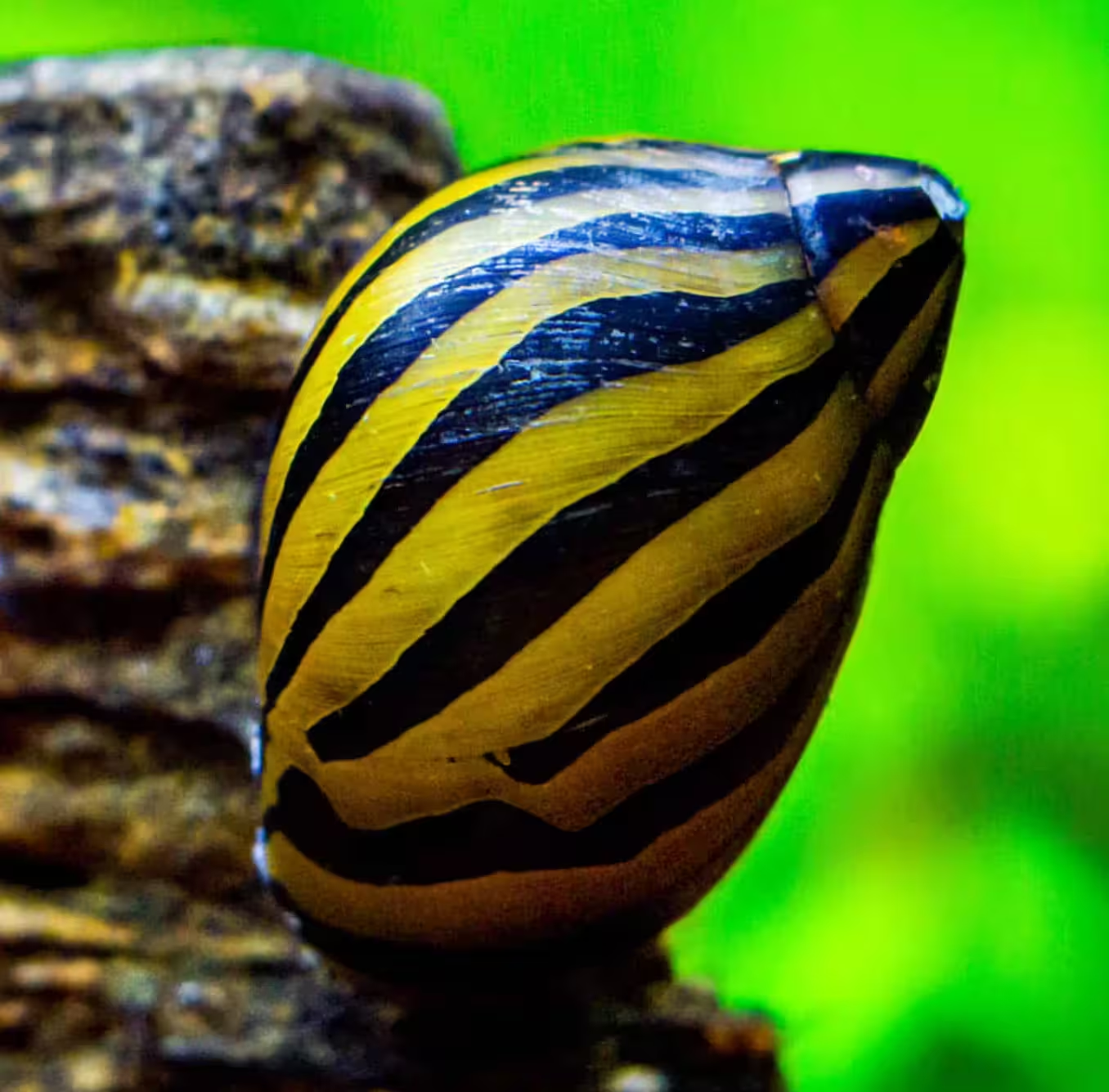
Nerite Snail
Neritina natalensisOne of the best algae-eating snails for aquariums. Won't reproduce in freshwater. Comes in various patterns like zebra, tiger, and olive.
Key Traits: Excellent algae control, can't breed in freshwater, lifespan 1-3 years

Assassin Snail
Clea helenaNamed for its habit of preying on other snails. Used to control pest snail populations in aquariums. Has striking yellow and brown striped shell.
Key Traits: Eats other snails, burrows in substrate, lifespan 2-3 years

Rabbit Snail
Tylomelania spp.Unique snail with elongated shell and "rabbit-like" face. Comes in various colors. Moves surprisingly quickly compared to other snails.
Key Traits: Peaceful, needs warm water (78-86°F), breeds slowly
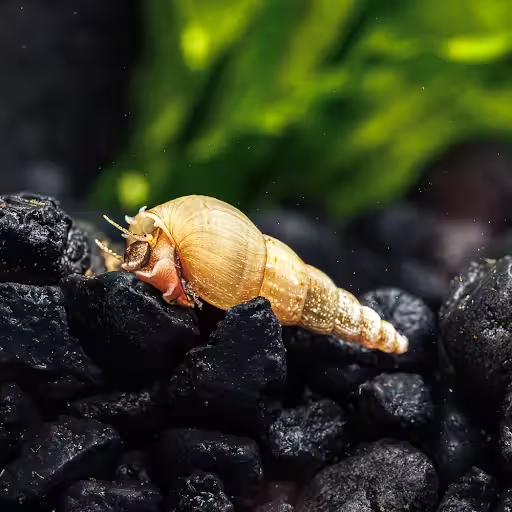
Malaysian Trumpet Snail
Melanoides tuberculataBurrowing snail that helps aerate substrate. Nocturnal and excellent at controlling detritus. Can reproduce rapidly in ideal conditions.
Key Traits: Live-bearing, beneficial for planted tanks, lifespan 1-2 years
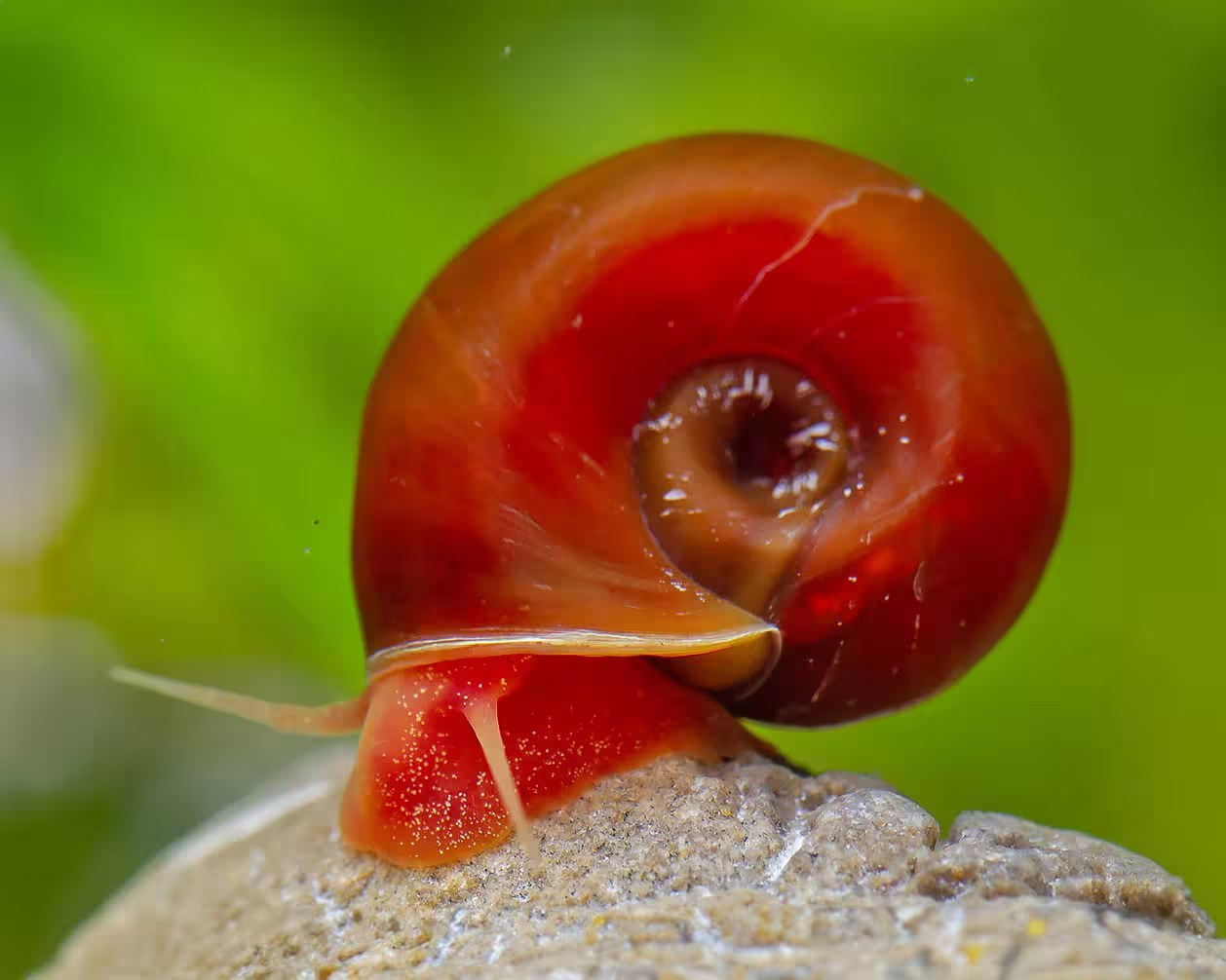
Ramshorn Snail
Planorbella spp.Named for its flat, coiled shell resembling a ram's horn. Comes in red, blue, and brown varieties. Excellent algae eater but can overpopulate.
Key Traits: Hermaphroditic, breathes air, lifespan 1 year
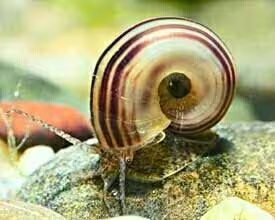
Colombian Ramshorn
Marisa cornuarietisLarger relative of common ramshorn snails. Used in biocontrol to eat aquatic weeds and snail eggs. Has distinctive striped shell.
Key Traits: Omnivorous, eats plants and other snails, lifespan 2-3 years

Chinese Mystery Snail
Cipangopaludina chinensisLarge invasive snail in North America. Can survive out of water for weeks by sealing its shell. Competes with native snail species.
Key Traits: Invasive, live-bearing, lifespan 5 years

Mud Bithynia
Bithynia tentaculataSmall snail that serves as intermediate host for parasitic flukes. Has operculum (trapdoor) to seal its shell. Found in Europe and North America.
Key Traits: Operculum present, host for parasites, lifespan 2 years
Invasive Species Alert
Many freshwater snails like the Chinese Mystery Snail and Golden Apple Snail are invasive outside their native ranges. Never release aquarium snails into the wild as they can disrupt local ecosystems.
Marine Snail Species (~30,000 species)
Marine snails inhabit oceans worldwide, from tidal zones to deep sea vents. They display incredible diversity in form and function.
| Category | Size Range | Characteristics | Habitat | Notable Species |
|---|---|---|---|---|
| Whelks | 5-40 cm | Carnivorous, strong shells | Coastal waters | Common Whelk, Lightning Whelk |
| Cones | 2-20 cm | Venomous, patterned shells | Tropical reefs | Geography Cone, Textile Cone |
| Periwinkles | 1-4 cm | Herbivorous, intertidal | Rocky shores | Common Periwinkle |
| Sea Butterflies | 0.5-5 cm | Pelagic, wing-like lobes | Open ocean | Limacina helicina |
| Deep-Sea Snails | 1-10 cm | Specialized adaptations | Deep ocean | Scaly-foot Gastropod |

Common Whelk
Buccinum undatumEdible marine snail with distinctive spiral shell. Common in North Atlantic waters. Carnivorous, feeding on bivalves and carrion using its proboscis.
Key Traits: Edible, strong shell, lifespan 10-15 years
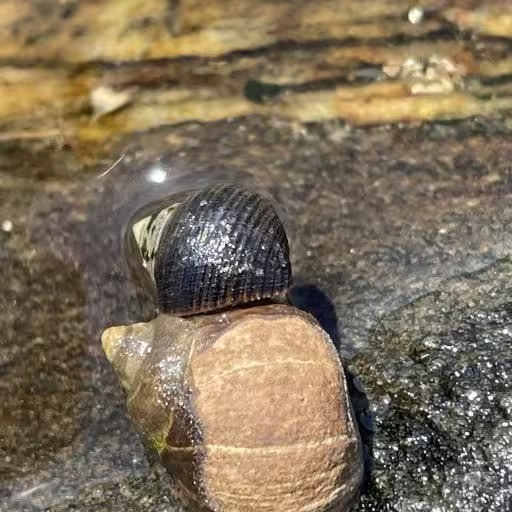
Common Periwinkle
Littorina littoreaSmall herbivorous snail that grazes on algae in intertidal zones. Can survive out of water for weeks by sealing its shell. Invasive in North America.
Key Traits: Edible, tolerates wide salinity range, lifespan 5-10 years
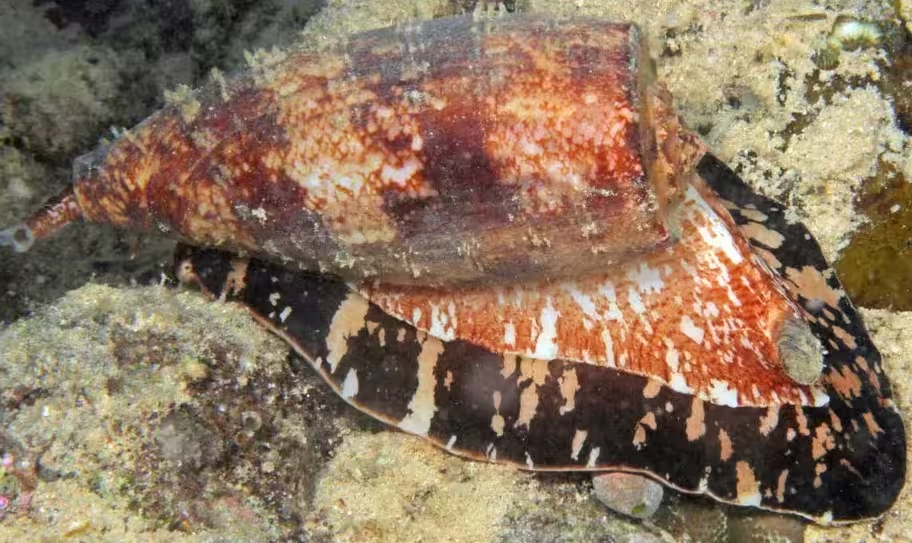
Geography Cone
Conus geographusHighly venomous marine snail. Harpoons fish with venomous radula tooth. Shell has map-like patterns. One of the most dangerous snails to humans.
Key Traits: Potentially lethal sting, carnivorous, lifespan 10-20 years
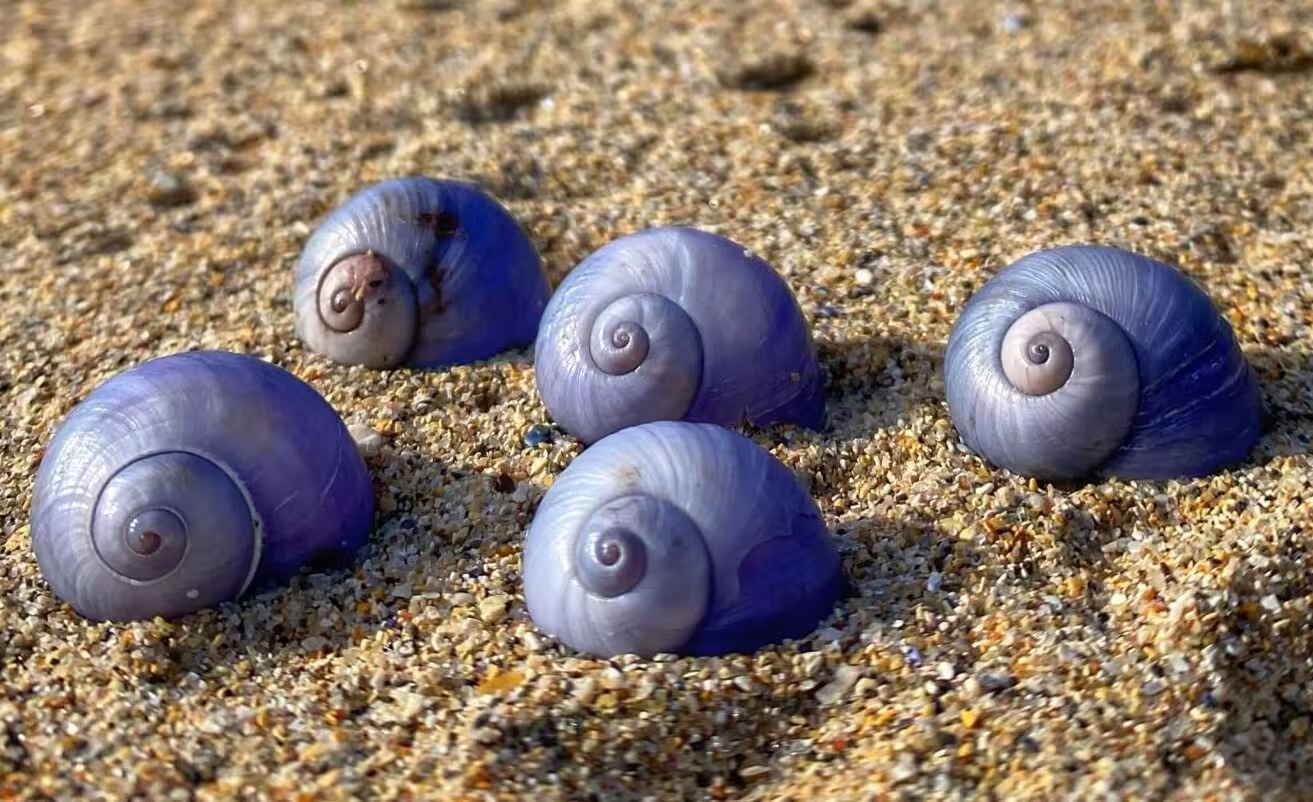
Violet Sea Snail
Janthina janthinaBeautiful purple snail that floats upside-down on bubble rafts it creates. Feeds on jellyfish and other pelagic creatures. Shell is thin and fragile.
Key Traits: Bubble raft, countershading (dark below, light above), lifespan 1-2 years
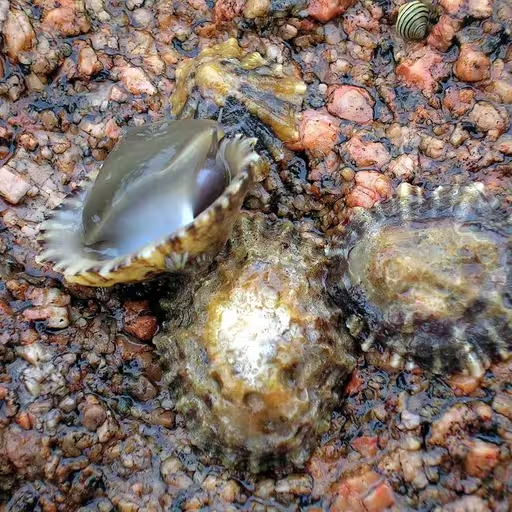
Common Limpet
Patella vulgataCone-shaped mollusk that clings tightly to rocks. Herbivorous, grazing on algae with its radula. Returns to the same "home scar" on the rock.
Key Traits: Strong adhesion, can live 15+ years, edible
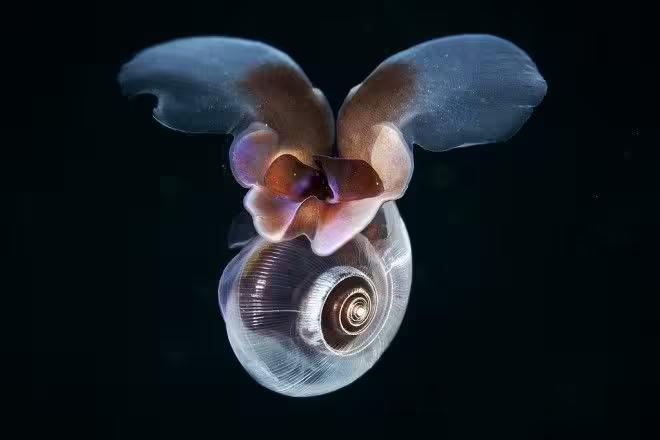
Sea Butterfly
Limacina helicinaSmall swimming sea snail with wing-like parapodia. Important part of polar food chains. Shell is transparent and delicate.
Key Traits: Floats in water column, sensitive to ocean acidification
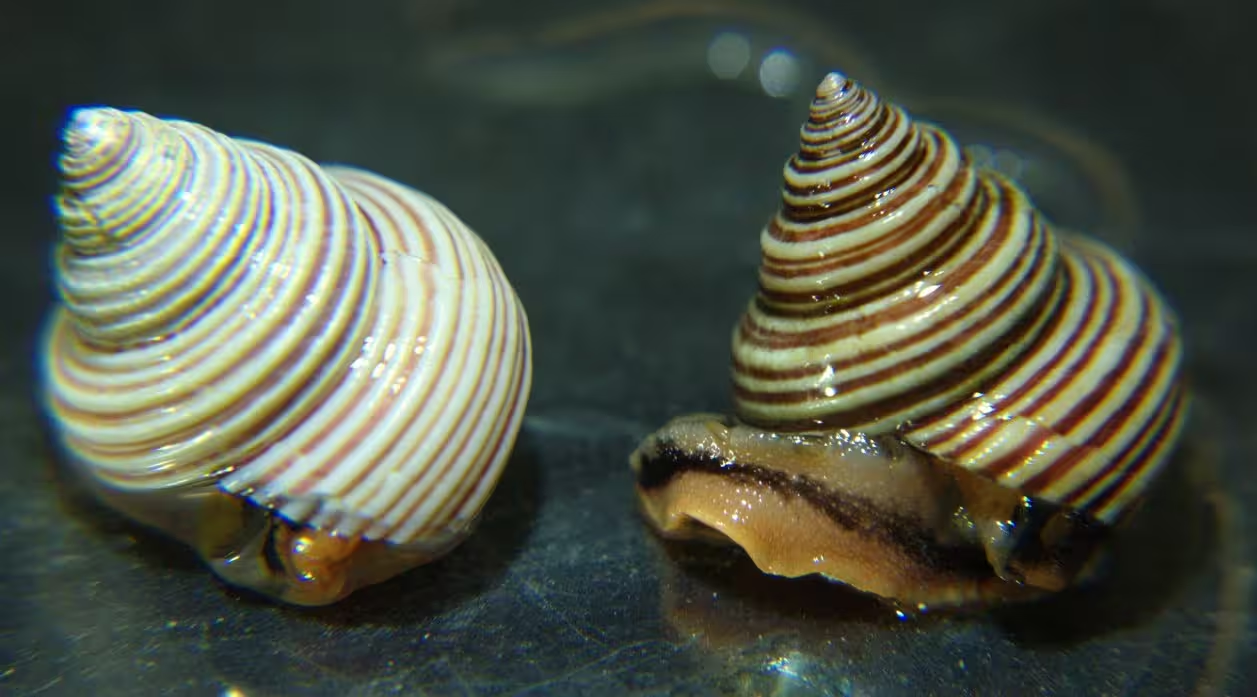
Valkyrie Snail
Calliostoma valkuriDeep-sea snail named after Norse Valkyries. Beautiful golden shell with intricate patterns. Found near hydrothermal vents.
Key Traits: Extreme environment adaptation, chemosynthetic symbionts
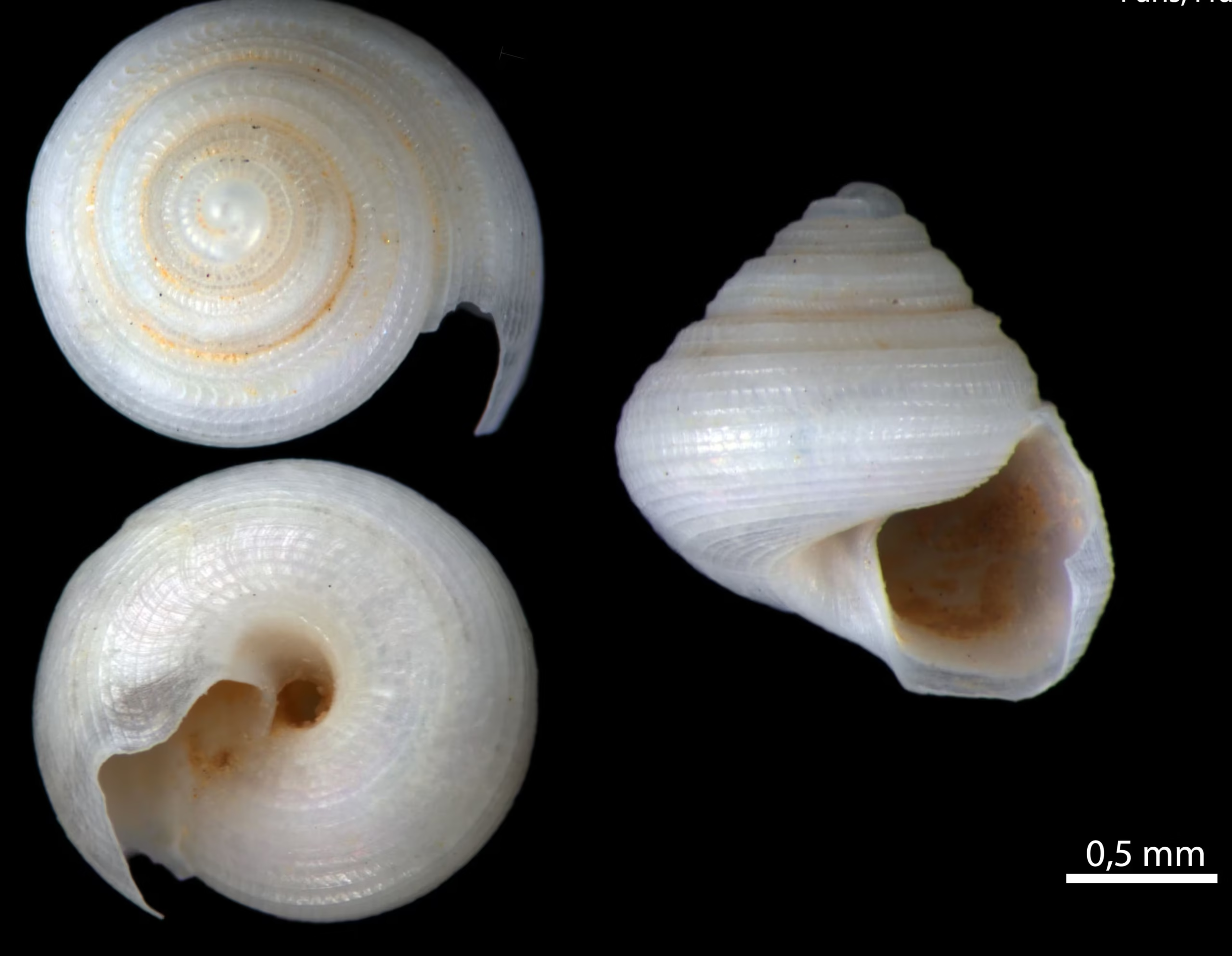
Umberlee's Snail
Halystina umberleeDeep-sea snail named after D&D sea goddess Umberlee. Found in Atlantic hydrothermal vent systems. Has unique shell morphology.
Key Traits: Vent specialist, named after fantasy character
Conservation Note
Many marine snails are threatened by ocean acidification which makes it difficult for them to form their shells. Collection of ornamental shells can also impact populations. Always check local regulations before collecting marine snails.
Popular Aquarium Snail Species
These snails are commonly kept in freshwater aquariums for their cleaning abilities and interesting behaviors.
| Type | Size | Key Features | Diet | Breeding |
|---|---|---|---|---|
| Nerite Snail | 1-3 cm | Excellent algae-eater, doesn't breed in freshwater | Algae, biofilm | Requires brackish water |
| Mystery Snail | 5-7 cm | Colorful varieties, plant-safe | Algae, detritus, vegetables | Lays eggs above water |
| Rabbit Snail | 5-10 cm | Long shell, "rabbit-like" face | Detritus, soft algae | Live-bearing, slow |
| Assassin Snail | 2-3 cm | Carnivorous, controls pest snails | Other snails | Slow, requires mates |
| Ramshorn Snail | 1-4 cm | Red or blue variants, rapid breeder | Algae, decaying plants | Hermaphroditic, fast |
Choosing Aquarium Snails
- Algae control: Nerite snails are best for algae, won't overpopulate
- Substrate cleaning: Malaysian Trumpet Snails burrow and aerate substrate
- Pest control: Assassin Snails eat other snails
- Display snails: Mystery Snails and Rabbit Snails are attractive centerpieces
- Breeding projects: Ramshorns and Pond Snails reproduce easily
Aquarium Requirements
- Water parameters: Most prefer pH 7.0-8.0, hardness 8-12 dGH
- Calcium: Essential for shell health - add cuttlebone or calcium supplements
- Temperature: 70-78°F for most species (higher for Rabbit Snails)
- Lid: Some snails (especially Mystery Snails) may crawl out
- Copper: Extremely toxic to all snails - avoid medications containing copper
Pro Tip: Snail Population Control
To control snail populations: reduce feeding (they thrive on excess food), manually remove egg clusters, add Assassin Snails, or introduce snail-eating fish like loaches. Avoid chemical treatments as they can harm other invertebrates.
Common Pest Snails
These snails often appear uninvited in aquariums via plants or decorations:
| Species | Identification | Control Methods | Image |
|---|---|---|---|
| Pond Snail | Teardrop shape, pointed shell | Reduce feeding, manual removal | 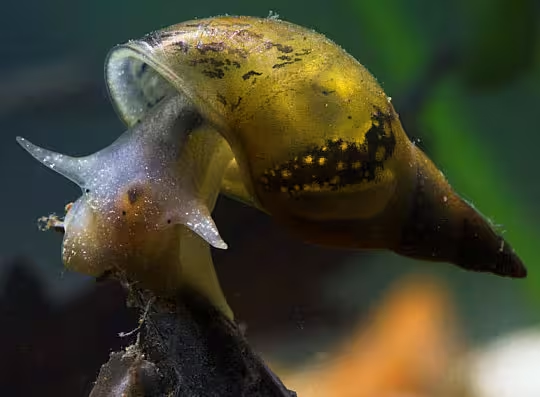 |
Complete Snail Care Guide
Snail Housing Requirements
Proper housing is essential for your snail's health and longevity. Requirements vary by species.
Enclosure Setup
- Terrarium size: Minimum 5 gallons for small species, 10+ gallons for giants
- Substrate: 2-4 inches of coconut fiber or pesticide-free soil (for burrowing species)
- Humidity: 70-90% for tropical species, mist daily (use hygrometer to monitor)
- Ventilation: Screen top to allow air exchange while maintaining humidity
- Hides: Cork bark, clay pots, or half-buried containers provide security
- Plants: Live plants like pothos or sphagnum moss help maintain humidity
Temperature & Lighting
- Temperature: 70-78°F for most species (use under-tank heater if needed)
- Lighting: Indirect natural light or low-wattage bulb (no UVB required)
- Day/night cycle: 12 hours light/12 hours dark mimics natural rhythm
- Heating: Use thermostat-controlled heat mat if room is cold
Pro Tip: Creating Microclimates
Create humidity gradients by having deeper substrate on one side of the enclosure and misting that area more heavily. This allows snails to choose their preferred moisture level. Use sphagnum moss in humid areas to help retain moisture.
Snail Nutrition Guide
A proper diet is crucial for healthy shell growth and overall snail health.
Diet Components
- Vegetables: Leafy greens (kale, romaine, spinach), zucchini, cucumber, sweet potato, carrots
- Calcium sources: Cuttlebone, eggshells, oyster grit, calcium powder (essential for shell growth)
- Protein: Fish flakes, boiled egg, bloodworms (once weekly for most species)
- Fruits: Occasional treats (apple, banana, melon) - high sugar content
- Avoid: Salty, processed, or acidic foods (citrus, onions, garlic)
Feeding Schedule
- Frequency: Offer fresh food daily, remove uneaten food after 24 hours
- Quantity: About as much as the snail can eat overnight
- Preparation: Wash thoroughly, cut into snail-sized pieces
- Variety: Rotate different vegetables to ensure balanced nutrition
- Calcium: Always available - place cuttlebone in enclosure
Foods to Avoid
- Toxic plants: Ivy, oleander, buttercups
- Processed foods: Bread, pasta, salty snacks
- Acidic foods: Citrus, tomatoes, vinegar
- Pesticides: Always use organic produce or wash thoroughly
- Dairy: Snails cannot digest lactose
Calcium Requirements
Snails need constant access to calcium for shell growth and repair. Provide multiple calcium sources: crushed eggshells mixed into substrate, whole cuttlebone, and calcium-rich vegetables like kale. Signs of calcium deficiency include thin, cracked, or peeling shells.
Snail Health Concerns
Understanding common health issues helps you provide better care and recognize when intervention is needed.
Shell Damage
Symptoms:
- Cracks or chips in shell
- Peeling shell layers
- Exposed mantle tissue
- Abnormal shell growth
Prevention/Treatment:
- Provide ample calcium sources
- Maintain proper humidity
- For minor damage: keep environment optimal for natural repair
- For severe damage: consult exotic vet for possible shell repair
Parasites
Symptoms:
- Lethargy
- Weight loss despite eating
- Visible mites or worms
- Abnormal feces
Prevention/Treatment:
- Quarantine new snails for 30 days
- Keep enclosure clean
- For mites: temporary substrate change to paper towels
- Consult vet for antiparasitic treatment
Preventive Care
- Quarantine: Isolate new snails for 30 days before introducing to others
- Cleaning: Spot clean daily, full substrate change every 2-3 months
- Observation: Check snails daily for activity levels and appetite
- Record keeping: Note feeding, growth, and behavior changes
Emergency Situations
- Not emerging from shell for several days
- Severe shell damage exposing internal organs
- Prolonged inactivity during normally active periods
- Visible parasites that don't resolve with cleaning
- Abnormal discharge from shell opening
Common Treatments & Costs
| Condition | Treatment | India (₹) | USA ($) | UK (£) |
|---|---|---|---|---|
| Shell Damage | Calcium supplements (cuttlebone, liquid calcium) | 50-200 | 5-15 | 4-12 |
| Parasites | Anti-parasitic solution (Praziquantel based) | 150-500 | 10-25 | 8-20 |
| Fungal Infection | Fungicide baths (Methylene blue) | 200-600 | 15-30 | 12-25 |
| Bacterial Infection | Antibacterial treatment (Kanamycin) | 300-800 | 20-40 | 15-35 |
Note: Prices are approximate and may vary by location and brand. Always consult a veterinarian for proper diagnosis and treatment.
Snail Breeding Guide
Understanding snail reproduction is important whether you plan to breed or prevent unwanted eggs.
Egg Laying
- Most land snails bury eggs in substrate
- Clutch size varies by species (30-400 eggs)
- Incubation period: 2-4 weeks depending on temperature
- Eggs are small, round, and pearly white
Hatching
- Babies emerge with soft, transparent shells
- First meal is often their own eggshell (calcium source)
- Extremely vulnerable to drying out
- Require same diet as adults, just smaller portions
Juvenile Stage
- Rapid growth with proper nutrition
- Shell becomes more opaque and colored
- Sexual maturity reached in 6-24 months
- Mortality highest in first few months
Adult Stage
- Full size reached in 1-3 years
- Reproductive prime varies by species
- Can produce multiple clutches per year
- Lifespan ranges from 2-15 years depending on species
Breeding Basics
- Hermaphrodites: Most land snails have both male and female organs
- Courtship: Can last several hours with elaborate rituals
- Egg care: Generally no parental care after laying
- Temperature: Warmer temps usually increase breeding activity
- Population control: Freeze unwanted eggs before disposing
Responsible Breeding
Only breed snails if you have homes lined up for all offspring. Many snail species are prolific breeders and can quickly overwhelm your capacity. Consider that some species like Giant African Land Snails are illegal to keep in some countries due to their invasive potential.
Handling & Interaction
Proper handling techniques ensure your snail's safety and reduce stress.
Safe Handling Techniques
- Wash hands thoroughly before and after (no lotions or soap residue)
- Handle over soft surface in case of falls
- Let snail crawl onto your hand rather than pulling it
- Support the shell fully - never hold by the shell opening
- Limit handling to 10-15 minutes to prevent drying out
- Keep away from face (some species may carry parasites)
Handling Precautions
- Avoid handling when snail is sealed in shell (indicates stress)
- Never force snail out of its shell
- Don't handle snails during extreme temperatures
- Supervise children closely during handling
- Wash produce thoroughly to remove pesticide residue
Bonding With Your Snail
While snails don't bond like mammals, they can learn to recognize safe environments. Regular, gentle handling at the same time each day can help your snail become more comfortable with interaction. Observe your snail's behavior - if it consistently retreats when handled, reduce handling frequency.
Snail Price Guide & Buying Tips
Snail prices vary based on species, rarity, and size. Below are approximate price ranges.
| Snail Type | India Price (₹) | USA Price ($) | UK Price (£) | Australia Price (A$) |
|---|---|---|---|---|
| Common Garden Snails | 50 - 200 | 1 - 5 | 1 - 4 | 2 - 10 |
| Giant African Land Snails | 300 - 1,500 | 10 - 30 | 8 - 25 | 15 - 50 |
| Mystery Snails (Aquarium) | 200 - 800 | 3 - 15 | 2 - 12 | 5 - 20 |
| Nerite Snails (Aquarium) | 250 - 1,000 | 4 - 20 | 3 - 15 | 7 - 25 |
| Rare Species (Candy Cane, etc.) | 1,000 - 5,000+ | 25 - 100+ | 20 - 80+ | 40 - 150+ |
Choosing a Healthy Snail
- Shell: Intact, no cracks or excessive wear
- Activity: Responds to gentle stimulation
- Body: No visible parasites or lesions
- Mantle: Visible and appears healthy (no discoloration)
- Environment: Seller keeps snails in clean, proper conditions
Where to Buy
- Reputable breeders: Best for specific species, can provide care advice
- Specialty pet stores: Often carry common aquarium species
- Online retailers: Verify reviews and shipping methods
- Local collectors: May have unique local species (ensure legal collection)
- Snail shows/conventions: Opportunity to meet breeders and see various species
- Avoid: Wild collection unless you're certain of species and legality
Adoption Option
Consider adopting snails from rescue organizations or hobbyists who can no longer care for their pets. Many aquarium snail species are frequently available for adoption as they reproduce readily in home aquariums.
Browse Available SnailsWhy Choose Snails as Pets?
Snails make fascinating and low-maintenance pets with unique characteristics.
Low Maintenance
Require less daily care than many pets
Fascinating
Unique behaviors and biology
Space Efficient
Thrive in small enclosures
Educational
Great for teaching biology concepts
Snails are ideal pets for apartments, dorm rooms, or anywhere space is limited. A basic 5-10 gallon terrarium can comfortably house several small to medium snails. Unlike noisy pets, snails are completely silent and won't disturb neighbors.
Under supervision, snails can teach children about responsibility, life cycles, and ecosystems. Their slow pace makes them less intimidating than faster pets. Caring for snails helps develop nurturing skills and scientific curiosity.
Watching snails move slowly through their environment can have a calming effect, reducing stress and anxiety. The routine of caring for snails provides structure and purpose. Their low demands make them ideal emotional support animals for some people.
Ready to Start Your Snail-Keeping Journey?
Explore our selection of healthy, well-cared-for snails from trusted breeders. Each purchase comes with detailed care instructions to ensure your new pet thrives.
Download This Complete Care Guide
Get this comprehensive snail encyclopedia in PDF format for offline reference or printing


